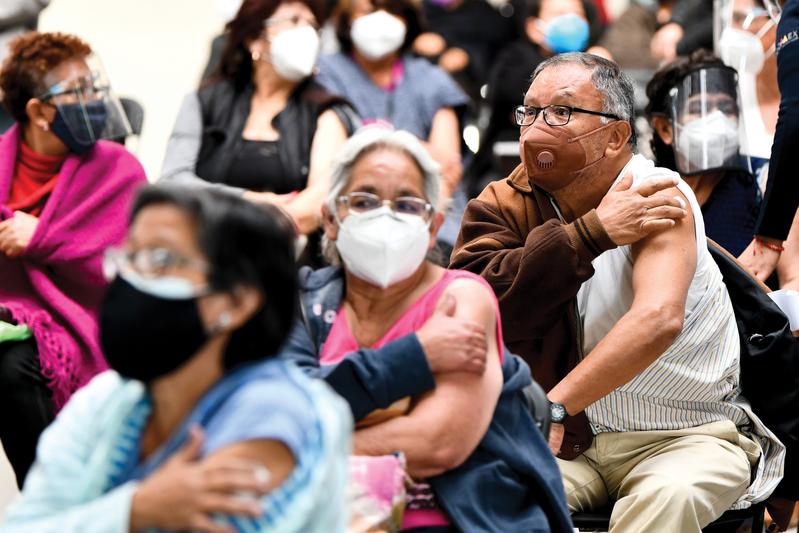 Citizens inoculated with Sinovac COVID-19 vaccines sit in an observation area at a vaccination site in Ecatepec, Mexico, on Feb 20. (XIN YUEWEI / XINHUA)
Citizens inoculated with Sinovac COVID-19 vaccines sit in an observation area at a vaccination site in Ecatepec, Mexico, on Feb 20. (XIN YUEWEI / XINHUA)
Hit hard by COVID-19, isolated Amazon rainforest communities in Latin America are getting some relief as a Chinese vaccine rollout is expected to keep at bay the pandemic that has left a trail of illness and death in the lungs of the world.
Intensive care units and cemeteries in Amazon cities like Manaus in Brazil and Leticia in Colombia were overwhelmed in recent months as a fresh wave of infections, led by a more contagious P.1 Brazilian strain of SARS-CoV-2 — the virus that causes the COVID-19 respiratory illness — wreaked havoc on local communities.
But things are now starting to change, as distribution of vaccines developed by China’s Sinovac Biotech is offering hope that the pandemic resurgence can be halted in the worst-hit areas.
Experts noted that Sinovac’s Coronavac offers logistics advantages compared to some vaccines from the West as the Chinese jabs do not require ultra-cold storage chains, making them more suitable for deployment in remote regions.
Coronavac “can be stored in common refrigerators and does not require ultra-freezing chains, allows it to be brought to more distant areas”, said Carlos Álvarez, national coordinator of COVID-19 studies in Colombia for the World Health Organization.
“It is an advantage of this vaccine.”
Colombia, and Mexico, welcomed the first batch of Coronavac over the past weekend.
Mexico began to administer the vaccine to hundreds of residents aged 60 and over at a vaccination site on Feb 20.
The first batch to Colombia arrived in a shipment of 192,000 doses from China to Bogota that were received in a high-profile ceremony that included President Ivan Duque and China’s Ambassador Lan Hu.
Of those, 40,355 doses were sent onwards to Leticia and other jungle areas by air, with vaccinations scheduled to begin on Feb 23.
“Given its proximity to Tabatinga (a border town in Brazil) and the triple border with Peru and Brazil, which did not make the right containment and mitigation strategy, Leticia has already seen three peaks of the pandemic,” said Luis Hernandez, director of the Covida project, an initiative from Los Andes University in Bogota, Colombia, to track the virus.
“It looks like the second and third peaks are related, beyond the spread of the P.1 strain, to the conditions of the population, agglomerations and border crossings,” he noted.
Last year, the city of Leticia had the highest prevalence rate for the virus, with almost 60 percent of the population testing positive for SARS-CoV-2 antibodies, which meant exposure at some point.
In Manaus, the capital of Brazil’s Amazonas state, the figure has surpassed 76 percent, according to a study.
“This unfortunate city has become a sentinel for how natural population immunity could influence future transmission. Events in Manaus reveal what tragedy and harm to society can unfold if this virus is left to run its course,” the study said.
The city of Manaus is connected by a river to Tabatinga and Leticia, 1,100 kilometers away. It can take 37 hours to get from the border cities to Manaus by boat.
For WHO’s Álvarez, getting the vaccines for the whole population in the Amazon and particularly in the Colombian side of the border right away, skipping the national strategy of vaccinating the population by groups starting with healthcare workers and the elderly, is the right choice.
“Vaccination in the Amazon is very important. From an epidemiologically perspective, is the right time to do it, given the presence of the P.1 strain in that territory,” he said.
The Covida project’s Hernandez agrees. “The sooner, the better, since there will be less chances for the virus to create new strains. If the population does not get vaccinated, there will be more chances of having new strains,” he said.
The challenge of conducting mass-scale vaccination in the Amazon is enormous, given the conditions of the jungle and the poor infrastructure to navigate its rivers and land.
“It takes one and a half hours to get from Leticia to La Chorrera in a single-engine aircraft. By boat it can be between 15 to 20 days,” noted Juan Seneray, a nursing technician at the only healthcare center in La Chorrera, a town located on the riverside of the Igará Paraná river, some 450 kilometers north-west from Leticia.
Despite being a small and hard to reach town with a population of only 3,878, La Chorrera has been deeply affected by the virus and seven people have died from it.
With the arrival of Sinovac’s vaccines, there is plenty of hope among the population in the Amazon, most of which is of indigenous origin.
“Indigenous authorities are working on the sensibilization campaign and most of the members of the community will accept… the jab. We need the vaccines to reach rural areas like ours as soon as possible,” said Seneray.


